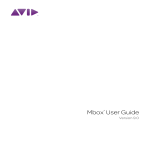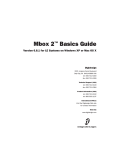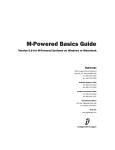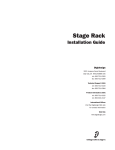Download M-Audio Pro Tools User guide
Transcript
Avid Vocal Studio User Guide ® Version 8.0.3 Legal Notices This guide is copyrighted ©2010 by Avid Technology, Inc., with all rights reserved. Under copyright laws, this guide may not be duplicated in whole or in part without the written consent of Avid Technology, Inc. Avid, Pro Tools SE and M-Audio are either trademarks or registered trademarks of Avid Technology, Inc. All other trademarks contained herein are the property of their respective owners. Product features, specifications, system requirements, and availability are subject to change without notice. Guide Part Number 8420-30237-01 REV A 06/10 Documentation Feedback At Avid, we are always looking for ways to improve our documentation. If you have comments, corrections, or suggestions regarding our documentation, email us at [email protected]. contents Chapter 1. Introduction . . . . . . . . . . . . . . . . . . . . . . . . . . . . . . . . . . . . . . . . . . . . . . . . . . . . . . 1 Vocal Studio Features . . . . . . . . . . . . . . . . . . . . . . . . . . . . . . . . . . . . . . . . . . . . . . . . . . . . . 1 System Requirements . . . . . . . . . . . . . . . . . . . . . . . . . . . . . . . . . . . . . . . . . . . . . . . . . . . . . 2 Hardware Registration . . . . . . . . . . . . . . . . . . . . . . . . . . . . . . . . . . . . . . . . . . . . . . . . . . . . . 2 Pro Tools SE Guide Set . . . . . . . . . . . . . . . . . . . . . . . . . . . . . . . . . . . . . . . . . . . . . . . . . . . . 2 Chapter 2. Installing Vocal Studio . . . . . . . . . . . . . . . . . . . . . . . . . . . . . . . . . . . . . . . . . . . . . 3 Installation Overview . . . . . . . . . . . . . . . . . . . . . . . . . . . . . . . . . . . . . . . . . . . . . . . . . . . . . . 3 Mac OS X . . . . . . . . . . . . . . . . . . . . . . . . . . . . . . . . . . . . . . . . . . . . . . . . . . . . . . . . . . . . . . 3 Windows . . . . . . . . . . . . . . . . . . . . . . . . . . . . . . . . . . . . . . . . . . . . . . . . . . . . . . . . . . . . . . 4 MP3 Export Option . . . . . . . . . . . . . . . . . . . . . . . . . . . . . . . . . . . . . . . . . . . . . . . . . . . . . . . 5 Hardware Connections. . . . . . . . . . . . . . . . . . . . . . . . . . . . . . . . . . . . . . . . . . . . . . . . . . . . . 6 Checking Your Signal Path . . . . . . . . . . . . . . . . . . . . . . . . . . . . . . . . . . . . . . . . . . . . . . . . . . 6 Software and System Configuration . . . . . . . . . . . . . . . . . . . . . . . . . . . . . . . . . . . . . . . . . . . 7 Chapter 3. The Software Control Panel . . . . . . . . . . . . . . . . . . . . . . . . . . . . . . . . . . . . . . . . 9 Accessing the Control Panel . . . . . . . . . . . . . . . . . . . . . . . . . . . . . . . . . . . . . . . . . . . . . . . . . 9 Levels Tab (All Systems) . . . . . . . . . . . . . . . . . . . . . . . . . . . . . . . . . . . . . . . . . . . . . . . . . . . 9 Latency Tab (Windows) . . . . . . . . . . . . . . . . . . . . . . . . . . . . . . . . . . . . . . . . . . . . . . . . . . . 10 About Tab (All Systems) . . . . . . . . . . . . . . . . . . . . . . . . . . . . . . . . . . . . . . . . . . . . . . . . . . . 10 Chapter 4. Using Vocal Studio . . . . . . . . . . . . . . . . . . . . . . . . . . . . . . . . . . . . . . . . . . . . . . . 11 Launching Pro Tools SE . . . . . . . . . . . . . . . . . . . . . . . . . . . . . . . . . . . . . . . . . . . . . . . . . . . 11 Recording Audio Tracks . . . . . . . . . . . . . . . . . . . . . . . . . . . . . . . . . . . . . . . . . . . . . . . . . . . 12 Opening a Recent Session . . . . . . . . . . . . . . . . . . . . . . . . . . . . . . . . . . . . . . . . . . . . . . . . . 13 Appendix A. Additional Information and Support . . . . . . . . . . . . . . . . . . . . . . . . . . . . . . . 15 Pro Tools SE . . . . . . . . . . . . . . . . . . . . . . . . . . . . . . . . . . . . . . . . . . . . . . . . . . . . . . . . . . . 15 M-Audio Drivers. . . . . . . . . . . . . . . . . . . . . . . . . . . . . . . . . . . . . . . . . . . . . . . . . . . . . . . . . 15 Before Updating Your System . . . . . . . . . . . . . . . . . . . . . . . . . . . . . . . . . . . . . . . . . . . . . . . 15 Contents iii Appendix B. Compliance Information . . . . . . . . . . . . . . . . . . . . . . . . . . . . . . . . . . . . . . . . . 17 Environmental Compliance . . . . . . . . . . . . . . . . . . . . . . . . . . . . . . . . . . . . . . . . . . . . . . . . 17 EMC (Electromagnetic Compliance) . . . . . . . . . . . . . . . . . . . . . . . . . . . . . . . . . . . . . . . . . . 18 Safety Compliance . . . . . . . . . . . . . . . . . . . . . . . . . . . . . . . . . . . . . . . . . . . . . . . . . . . . . . 18 iv Avid Vocal Studio User Guide chapter 1 Introduction Welcome to Avid® Vocal Studio. Vocal Studio turns your Mac or PC into a complete music production and recording environment, by combining an M Audio® Producer USB™ and Pro Tools® SE from Avid®. Your M-Audio Producer USB™ is a professional quality microphone designed for a wide variety of uses, such as music production, voice-overs, and podcasting. Featuring a built-in pro recording soundcard, Producer USB integrates easily with your computer via a standard USB connection. Vocal Studio Features M-Audio Producer USB • High-quality, USB powered, 16mm cardioid microphone • 1/8-inch headphone/line output jack • Blue power LED indicator Pro Tools SE music production software Pro Tools is the industry standard platform in music production software that is used in top recording facilities around the world. Whether you're new to music production or a seasoned professional wanting to take Pro Tools SE on the road, this package includes what you need for a professional-quality recording setup. Please take the time to read this User Guide. It will explain how to get the best performance out of your Vocal Studio. Chapter 1: Introduction 1 System Requirements Minimum System Requirements can be found on the Avid website at www.avid.com. A qualified version of Adobe® Flash® Player is required. Hardware Registration Please register your product online at www.avid.com/support. By doing so, you become eligible to receive the following: • Technical support information • Software update and upgrade notices • Hardware warranty information Pro Tools SE Guide Set Complete documentation can be accessed via the Help Menu. Interactive Guides and Tutorials Interactive guides and tutorials can be accessed via the Pro Tools SE Quick Start dialog or the Help Menu while the program is running. 2 Avid Vocal Studio User Guide Conventions Used in This Guide The following symbols are used to highlight important information: User Tips are helpful hints for getting the most from your system. Important Notices include information that could affect your data or the performance of your system. Cross References point to related sections in this and other Avid guides. chapter 2 Installing Vocal Studio This chapter shows you how to install Avid Vocal Studio on Mac OS X and Windows. 3 When the disc opens, double-click the in- staller icon to launch the installation. Installation Overview The Vocal Studio installation includes the following steps: 1 Installing Pro Tools SE. 2 Installing M-Audio Producer USB driver. 3 Connecting M-Audio Producer USB. Vocal Studio Installer Icon 4 Software configuration. 4 Click “Continue” on the Welcome screen, and follow all on-screen instructions. 5 System Configuration. Mac OS X The Pro Tools SE DVD runs a two-stage installation process. Stage 1 installs Pro Tool SE, and Stage 2 installs the Producer USB driver. It is important to carefully read and follow all on-screen instructions. To install Vocal Studio: Pro Tools SE - Welcome Screen 1 Make sure Producer USB is not connected to your computer. 2 Insert the installation DVD into your com- puter. Chapter 2: Installing Vocal Studio 3 5 When the following screen appears, click “Continue” and follow the on-screen instructions. Windows The Pro Tools SE DVD runs a two-stage installation process. Stage 1 installs Pro Tool SE, and Stage 2 installs the Producer USB driver. It is important to carefully read and follow all on-screen instructions. To install Vocal Studio: 1 Make sure Producer USB is not connected to your computer. 2 Insert the installation DVD into your com- Click Continue Software instrument content is very large and may take up to 30 minutes to install. During this time, the progress bar may not appear to move but your software is still installing. Do not terminate your installation. puter. In Windows 7, if the User Account Control dialog appears, click “Allow.” If the Welcome screen doesn’t appear, locate and double-click Setup.exe. 6 Choose the picture of Producer USB on the next screen, click “Continue” and follow the onscreen instructions to install the Producer USB driver. Pro Tools SE - Welcome Screen 3 Click “Continue” to install Pro Tools SE. Driver Selection - Producer USB 7 Once the installation is complete and your computer has been restarted, connect Producer USB to an available USB port on your computer. 4 Avid Vocal Studio User Guide Software instrument content is very large and may take up to 30 minutes to install. During this time, the progress bar may not appear to move but your software is still installing. Do not terminate your installation. 4 When the following screen appears, choose 8 Click “Finish” once the software has been in- the picture of Producer USB and follow the onscreen instructions to install the Producer USB driver. stalled. If the Found New Hardware Wizard reappears, repeat steps 6 through 8. If the Windows Logo Testing or “trusted application dialog appears, Click “Continue Anyway” (Windows XP) or “Install” (Windows 7). MP3 Export Option Driver Selection - Producer USB You may be notified that the driver being installed has not passed Windows Logo Testing, or asked whether the program you wish to run is a trusted application. Click “Continue Anyway” (Windows XP) or “Install” (Windows 7) to proceed with the installation. 5 Once the installation is complete and your computer has restarted, connect Producer USB to an available USB port on your computer. Windows XP users may encounter additional dialog boxes. If so, proceed with steps 6 through 8. 6 Windows XP will ask if you want to search the The MP3 Export Option lets you create MP3 files from Pro Tools sessions when exporting a region or a Timeline selection as a new audio file. With the MP3 Export Option, the MP3 file type is available when using File > Export > Audio. Pro Tools uses the Fraunhofer codec for encoding MP3 files. Authorizing the MP3 Export Option The MP3 Export Option is a paid option and can be purchased and authorized when you export an audio file as an MP3. To authorize the MP3 Export Option using an authorization code: 1 Launch Pro Tools. 2 Open a session. internet for a driver. Choose “No, not this time” and click “Next.” 3 Click on a region or make a Timeline selection and choose File > Export > Audio. 7 If the Found New Hardware Wizard dialog ap- 4 Select Compressed MP3 as the File Type. pears, choose “Install the software automatically” and click “Next.” 5 Click Export. 6 In the Pro Tools MP3 Option dialog, click Au- thorize. 7 In the Pro Tools MP3 Export Option dialog, select Manual Activation, then click Next. Chapter 2: Installing Vocal Studio 5 8 In the Pro Tools MP3 Export Option dialog, deselect the Use my iLok Smart Key option, then click Next. 9 When prompted, enter your Pro Tools MP3 Export Option serial code (authorization code). 10 Click Next and follow the on-screen instructions to complete the authorization process. Hardware Connections Once Pro Tools SE and the Producer USB driver have been installed, connect Producer USB to an available USB port on your computer as shown in the illustration below: Headphone Connection Checking Your Signal Path Listening to Demo Songs Listening to demo songs is an easy way to verify audio. To hear the audio from Pro Tools you will need your headphones or speakers connected to your audio interface. To listen to a demo song: 1 Use the Pro Tools SE icon to launch the pro- gram: Connecting Producer USB Headphones are connected to your Producer USB microphone as shown in the following illustration. • Mac Click on the Pro Tools SE icon in the Dock (or double-click the application icon in the Pro Tools folder inside the Digidesign folder). • Windows Click the Start button and locate the Pro Tools SE icon (or double-click the application icon in the Pro Tools folder inside the Digidesign folder). Pro Tools SE Icon 6 Avid Vocal Studio User Guide 2 Select the Demo Songs button. Software and System Configuration Pro Tools SE automatically selects and configures M-Audio Producer USB for audio recording. Detailed information explaining how to configure your system for optimum performance can be found in the Pro Tools SE User Guide. Pro Tools SE Quick Start Dialog - Demo Songs 3 From the list of music styles, select the cate- gory you want (or select an item from a submenu). This important information covers both Mac OS X and Windows systems, and includes tips on hard drive configuration and maintenance. We strongly recommend reading these chapters to ensure the best performance from your Pro Tools SE system. 4 Click Audio Preview to listen to the song. If you want to open the song in a Pro Tools session click Choose. Whether you click Audition Preview or the play button in the open demo session, you will hear the song playing in your headphones. Before auditioning or playing the demo song, open the Software Control as described in Chapter 3, “The Software Control Panel”and turn the Output Volume all the way down, then raise it to a suitable level once the song is playing. If you do not hear anything, check your hardware connections, and check your signal levels as explained in Chapter 3, “The Software Control Panel” then repeat step 4. Chapter 2: Installing Vocal Studio 7 8 Avid Vocal Studio User Guide chapter 3 The Software Control Panel The Software Control Panel lets you adjust settings such as input gain, monitor mix levels, and output volume. Accessing the Control Panel Mac OS X The Software Control Panel can be found in System Preferences, under “Other.” Windows Double-click the M-Audio logo located in the system tray, generally located at the bottom right of your Windows desktop. Levels Tab (All Systems) Input Gain This slider controls the level coming from the microphone. If the Pro Tools SE input meters are showing red, lower the input gain level. Monitor Mix This slider controls the signal level from the input that is sent directly to the output of Producer USB, and has no effect on what is actually recorded. The signal is mixed with the output from Pro Tools SE and allows you to hear the input signal before any software audio processing takes place. This monitoring method, called “Direct Monitoring” or “Hardware Monitoring,” prevents undesirable delays (latency) common when monitoring your input signal through Pro Tools SE. When monitoring your input using the Monitor Mix Control, click the Mute button on the Pro Tools SE track you are recording on. This stops the track from outputting the signal being recorded, and prevents “double-monitoring,” that causes undesired “phasing” or echo. Output Volume This slider controls the level of the output signal from Pro Tools to the Producer USB integrated 1/8-inch headphone/line output. Producer USB Control Panel, Levels Tab Chapter 3: The Software Control Panel 9 Latency Tab (Windows) Mac OS X In Mac OS X, the buffer size is adjusted within Pro Tools SE by choosing the File Menu > Preferences to open the Preferences dialog, then choose the Audio page. This lets you choose one of the two radio buttons in the lower half of the dialog. Refer to the Pro Tools SE User Guide for more information about setting the buffer size and other important settings when configuring Pro Tools SE. Producer USB Control Panel, Latency Tab Latency is the time it takes for an input signal to pass through your recording software and appear at the outputs. This latency can result in a delay when overdubbing to existing tracks. About Tab (All Systems) This slider lets you adjust the buffer size in units of samples. The default buffer size is 256 samples. Smaller buffer sizes result in lower latency, but may cause clicks, pops and dropouts on slower systems. If you are experiencing clicks and pops in your recording, try increasing the buffer size. To adjust the buffer size in Pro Tools SE, choose File > Preferences to open the Preferences dialog, then choose the Audio page. This lets you choose one of the two radio buttons in the lower half of the dialog. Refer to the Pro Tools SE User Guide for more information about setting the buffer size and other important settings when configuring Pro Tools SE. 10 Avid Vocal Studio User Guide Producer USB Control Panel, About Tab This page contains information about your hardware and current driver versions. These details are helpful should you ever have to contact technical support. Clicking the links takes you to useful pages on the Avid website. chapter 4 Using Vocal Studio Launching Pro Tools SE The first step in beginning a Pro Tools project is working with a session. Pro Tools provides a Quick Start dialog on launch that lets you quickly and easily work with session templates, listen to demo songs and view tutorials. To launch Pro Tools SE and open a session: 1 Use the Pro Tools SE icon to launch the pro- • Open and view tutorials. The Pro Tools SE tutorials can be accessed via the Help menu at any time. Creating a Session From a Template To create a new session from a template: 1 Select the New Session button. gram: • Mac Click on the Pro Tools SE icon in the Dock (or double-click the icon in the Pro Tools folder inside the Digidesign folder). • Windows Click the Start button and locate the Pro Tools SE icon (or double-click the icon in the Pro Tools folder inside the Digidesign folder). Pro Tools SE Quick Start Dialog - New Session 2 Select any session template from the list. Pro Tools SE Icon 2 Use the Quick Start dialog to do one of the fol- lowing: • Create a session from templates. • Listen to demo songs (lets you verify sound). See “Checking Your Signal Path” on page 6. 3 Click the Choose to open the template. 4 In the Save As dialog, name the session, choose where you want to save the session, and click Save. • Open any other session on your system. Chapter 4: Using Vocal Studio 11 Recording Audio Tracks This section shows you how to record an audio track in Pro Tools SE. To record an audio track: 1 On the Levels tab of the Software Control Track Record Enable Button and Fader in Record Mode Panel, turn the Input Gain Control all the way down. 6 Sing, or play an instrument at the loudest level 2 Choose an Audio track by clicking on an ap- propriate track name, such as “Audio 1” on the left side of the Pro Tools SE Edit window. To create a track, go to the Track menu, click Track > New and choose Audio track. you expect to occur during your recording, while slowly increasing the Input Gain in the Software control Panel, until the level meter for the track is in the red. Placing a pop filter between the microphone and a vocalist can improve recording quality by reducing the impact of sibilance and plosives during a vocal performance. Raising or lowering the Track fader will not affect the input level, as it only controls the track playback volume. Audio Track 3 Click on the Input Selector (In) to the left of the track name, and choose “Input 1” as the input source. 7 While continuing to sing or play, lower the Input Gain in the Software Control Panel, and stop at the point where the level meter is no longer in the red. 8 In the Software Control Panel, increase the Input Selector 4 Click the Mute button for the track to prevent it from sending the input signal to the output of Producer USB. Monitor Mix Level to a suitable volume so that you can hear the input signal. This is especially useful when recording in a session with pre-recorded tracks, because it lets you adjust the balance between the existing tracks and your input signal. 9 Using the on-screen transport controls, Re- Track Mute Button 5 Switch the track to record mode by clicking its Record Enable button. While the track is record enabled, the button and the track fader will be red. 12 Avid Vocal Studio User Guide cord Arm Pro Tools SE by clicking the Record button. Record Button 10 Begin recording your performance by click- ing the Play button. Opening a Recent Session To open a recent session: Play Button 11 Click the Stop button in the transport win- dow when you have finished recording your performance. 1 Launch Pro Tools SE. 2 When the Pro Tools SE Quick Start dialog ap- pears click the Open Session button. Stop Button 12 Press the Record Enable button to take the track out of record mode. 13 Press the Mute button for the track, so that you can hear your recording during playback. Do not forget to save your work. Pro Tools SE Quick Start Dialog - Open Session 3 From the list of recent session templates, se- lect the one you want. (Or, select Open Other... to select other recent sessions.) 4 Click to open the session. Chapter 4: Using Vocal Studio 13 14 Avid Vocal Studio User Guide appendix a Additional Information and Support Pro Tools SE Before Updating Your System Complete documentation for Pro Tools SE can be found in the Pro Tools SE Help menu. Please check www.avid/support for a compatible driver before installing Apple or Microsoft operating system updates. Additional information can be found in the Interactive Projects Guide and the Interactive Projects Tutorials, which you can access by clicking the Tutorials button in the upper right of the Pro Tool SE Quick Start dialog, or by going to the Help menu. M-Audio Drivers Should you experience any performance issues with your M-Audio hardware, please confirm that you have installed the latest M-Audio drivers. A complete list of current drivers and system requirements can be found at www.avid.com/support. Before new device drivers are released, they are tested for use with operating system versions that are available at that time. When updates for an operating system are released, all Avid device drivers have to be re-tested and possibly updated to ensure proper operation. We recommend not installing operating system updates until a driver has been posted to the Avid website for your operating system. The Avid website (www.avid.com) contains the latest drivers and program updates, as well as useful links to news stories, FAQs, and technical support. We recommend checking this site regularly to ensure you have the latest drivers and up-to-date information about this product. Appendix A: Additional Information and Support 15 16 Avid Vocal Studio User Guide appendix b Compliance Information Environmental Compliance Disposal of Waste Equipment by Users in the European Union Proposition 65 Warning This product contains chemicals, including lead, known to the State of California to cause cancer and birth defects or other reproductive harm. Wash hands after handling. Perchlorate Notice This product may contain a lithium coin battery. The State of California requires the following disclosure statement: “Perchlorate Material – special handling may apply, See www.dtsc.ca.gov/hazardouswaste/perchlorate.” This symbol on the product or its packaging indicates that this product must not be disposed of with other waste. Instead, it is your responsibility to dispose of your waste equipment by handing it over to a designated collection point for the recycling of waste electrical and electronic equipment. The separate collection and recycling of your waste equipment at the time of disposal will help conserve natural resources and ensure that it is recycled in a manner that protects human health and the environment. For more information about where you can drop off your waste equipment for recycling, please contact your local city recycling office or the dealer from whom you purchased the product. Recycling Notice Appendix B: Compliance Information 17 EMC (Electromagnetic Compliance) Australian Compliance Avid declares that this product complies with the following standards regulating emissions and immunity: • FCC Part 15 Class A • EN55022 Class A • EN55024 • AS/NZS CISPR 22 Class A • CISPR 22 Class A Canadian Compliance FCC Compliance for United States This Class A digital apparatus complies with Canadian ICES-003 Radio and Television Interference This equipment has been tested and found to comply with the limits for a Class A digital device, pursuant to Part 15 of the FCC Rules. Avid Cet appareil numérique de la classe A est conforme à la norme NMB-003 du Canada CE Compliance (EMC and Safety) DECLARATION OF CONFORMITY We, Avid, 2001 Junipero Serra Boulevard Daly City, CA 94014-3886, USA 650-731-6300 declare under our sole responsibility that the product Producer USB complies with Part 15 of FCC Rules. Operation is subject to the following two conditions: (1) this device may not cause harmful interference, and (2) this device must accept any interference received, including interference that may cause undesired operation. Communication Statement NOTE: This equipment has been tested and found to comply with the limits for a Class A digital device, pursuant to Part 15 of the FCC Rules. These limits are designed to provide reasonable protection against harmful interference in a residential installation. This equipment generates, uses, and can radiate radio frequency energy and, if not installed and used in accordance with the instructions, may cause harmful interference to radio communications. However, there is no guarantee that interference will not occur in a particular installation. If this equipment does cause harmful interference to radio or television reception, which can be determined by turning the equipment off and on, the user is encouraged to try and correct the interference by one or more of the following measures: • Reorient or locate the receiving antenna. • Increase the separation between the equipment and receiver. • Connect the equipment into an outlet on a circuit different from that to which the receiver is connected. • Consult the dealer or an experienced radio/TV technician for help. Any modifications to the unit, unless expressly approved by Avid, could void the user's authority to operate the equipment. 18 Avid Vocal Studio User Guide Avid is authorized to apply the CE (Conformité Europénne) mark on this compliant equipment thereby declaring conformity to EMC Directive 2004/108/EC and Low Voltage Directive 2006/95/EC. Safety Compliance Safety Statement This equipment has been tested to comply with USA and Canadian safety certification in accordance with the specifications of UL Standards: UL 60950-1, 1st edition/ IEC 60950-1, 1st edition and Canadian CAN/CSA-C22.2 No. 60950-1, Avid Inc., has been authorized to apply the appropriate UL & CUL mark on its compliant equipment. Warning Important Safety Instructions 1) Read these instructions. 12) For products that are not rack-mountable: Use only with a cart, stand, tripod, bracket, or table specified by the manufacturer, or sold with the equipment. When a cart is used, use caution when moving the cart/equipment combination to avoid injury from tip-over. 2) Keep these instructions. 3) Heed all warnings. 4) Follow all instructions. 5) Do not use this equipment near water. 6) Clean only with dry cloth. 7) Do not block any ventilation openings. Install in accordance with the manufacturer’s instructions. 8) Do not install near any heat sources such as radiators, heat registers, stoves, or other equipment (including amplifiers) that produce heat. 9) Do not defeat the safety purpose of the polarized or grounding-type plug. A polarized plug has two blades with one wider than the other. A grounding type plug has two blades and a third grounding prong. The wide blade or the third prong are provided for your safety. If the provided plug does not fit into your outlet, consult an electrician for replacement of the obsolete outlet. 13) Unplug this equipment during lightning storms or when unused for long periods of time. 14) Refer all servicing to qualified service personnel. Servicing is required when the equipment has been damaged in any way, such as power-supply cord or plug is damaged, liquid has been spilled or objects have fallen into the equipment, the equipment has been exposed to rain or moisture, does not operate normally, or has been dropped. 15) For products that are a Mains powered device: The equipment shall not be exposed to dripping or splashing and no objects filled with liquids (such as vases) shall be placed on the equipment. Warning! To reduce the risk of fire or electric shock, do not expose this equipment to rain or moisture. 16) For products containing a lithium battery: CAUTION! Danger of explosion if battery is incorrectly replaced. Replace only with the same or equivalent type. 17) The equipment shall be used at a maximum ambient temperature of 40° C. 10) Protect power cords from being walked on or pinched particularly at plugs, convenience receptacles, and the point where they exit from the equipment. 11) Only use attachments/accessories specified by the manufacturer. Japan PSE Safety Appendix B: Compliance Information 19 Avid Technical Support (USA) Product Information 5795 Martin Road Irwindale, CA 91706-6211 USA Visit the Online Support Center at www.avid.com/support For company and product information, visit us on the web at www.avid.com
























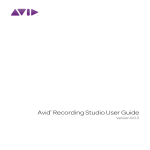
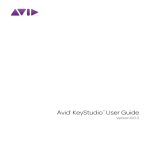
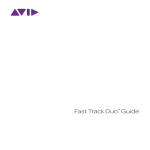
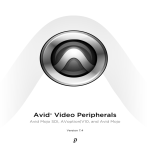
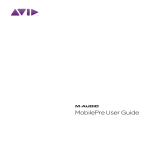


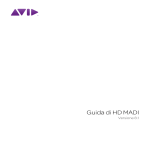

![Stage 48 - akmedia.[bleep]digidesign.](http://vs1.manualzilla.com/store/data/007247961_1-0fc36f720a3108317a47260e3de3799a-150x150.png)
